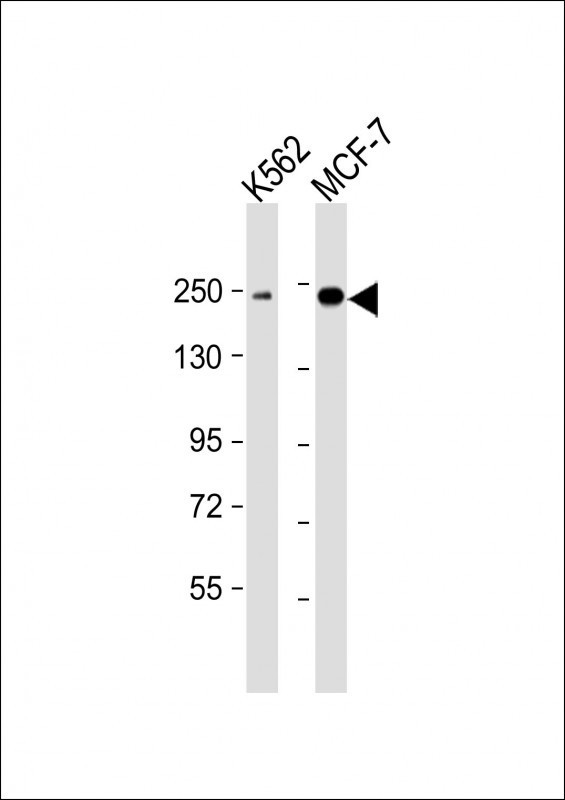
Mouse Anti-XRN1 antibody
XRN1_HUMAN; Dhm2; mXRN1; SEP1; Strand-exchange protein 1 homolog; 5'-3' exoribonuclease 1.
View History [Clear]
Details
Product Name XRN1 Chinese Name XRN1单克隆抗体 Alias XRN1_HUMAN; Dhm2; mXRN1; SEP1; Strand-exchange protein 1 homolog; 5'-3' exoribonuclease 1. Research Area Chromatin and nuclear signals Epigenetics Immunogen Species Mouse Clonality Monoclonal Clone NO. F12D4 React Species Human, (predicted: Mouse, ) Applications WB=1:500-2000
not yet tested in other applications.
optimal dilutions/concentrations should be determined by the end user.Theoretical molecular weight 193kDa Cellular localization The nucleus Form Liquid Concentration 1mg/ml immunogen Recombinant human XRN1 between 1455-1706 amino acids. Lsotype IgG1,k Purification affinity purified by Protein G Buffer Solution 0.01M TBS(pH7.4) with 1% BSA, 0.03% Proclin300 and 50% Glycerol. Storage Shipped at 4℃. Store at -20 °C for one year. Avoid repeated freeze/thaw cycles. Attention This product as supplied is intended for research use only, not for use in human, therapeutic or diagnostic applications. PubMed PubMed Product Detail This gene encodes a member of the 5'-3' exonuclease family. The encoded protein may be involved in replication-dependent histone mRNA degradation, and interacts directly with the enhancer of mRNA-decapping protein 4. In addition to mRNA metabolism, a similar protein in yeast has been implicated in a variety of nuclear and cytoplasmic functions, including homologous recombination, meiosis, telomere maintenance, and microtubule assembly. Mutations in this gene are associated with osteosarcoma, suggesting that the encoded protein may also play a role in bone formation. Alternative splicing results in multiple transcript variants. [provided by RefSeq, Sep 2013]
Function:
Lamins are type V intermediate filament proteins and are grouped into constitutively expressed B-type lamins and developmentally regulated A-type lamins. Lamin-binding proteins in the nuclear lamina and the nuclear interior include several protein families and/or types of proteins in higher eukaryotes such as the inner nuclear membrane proteins, lamin B receptor, emerin, MANI, three isoforms of lamina-associated polypeptide 1 (LAP 1), and several isoforms of LAP 2. Up to six LAP 2 isoforms derive from a single gene by alternative splicing in mammals and various isoforms have been described in Xenopus. The best characterized LAP2 isoforms are the inner nuclear membrane protein LAP 2 beta and the nucleoplasmic protein LAP 2 alpha, which are identical in their N-terminal 187-amino acid constant region but differ in their C termini. LAP 2 alpha specifically interacts with A-type lamins within the nuclear interior as part of a detergent- and salt-resistant nucleoskeletal structure.
Subunit:
Interacts with LMNA, BANF1 and RB1 and with chromosomes. Associates directly or indirectly with lamins at specific cell-cycle stages.
Subcellular Location:
Nuclear.
Tissue Specificity:
Expressed in many tissues. Most abundant in adult thymus and fetal liver.
Post-translational modifications:
Phosphorylated in a mitose-specific manner.
DISEASE:
Cardiomyopathy, dilated 1T (CMD1T) [MIM:613740]: A disorder characterized by ventricular dilation and impaired systolic function, resulting in congestive heart failure and arrhythmia. Patients are at risk of premature death. Note=The disease is caused by mutations affecting the gene represented in this entry.
Similarity:
Belongs to the LEM family.
Contains 1 LEM domain.
Contains 1 LEM-like domain.
SWISS:
Q8IZH2
Gene ID:
54464
Database links:Entrez Gene: 54464 Human
SwissProt: Q8IZH2 Human
Product Picture
Bought notes(bought amounts latest0)
No one bought this product
User Comment(Total0User Comment Num)
- No comment



 +86 571 56623320
+86 571 56623320




